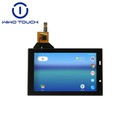Capacitive touch screens play an important role in telemedicine and interactive communication. With the continuous development of information technology and the upgrading of medical services, telemedicine has become one of the important means to solve the uneven distribution of medical resources and improve medical efficiency. The application of capacitive touch screen makes telemedicine and interactive communication more convenient and intuitive, which greatly promotes the communication between doctors and patients and the provision of medical services. This paper will discuss in detail the role of capacitive touch screen in telemedicine and interactive communication from the following aspects.
First, the capacitive touch screen provides an intuitive operating interface to facilitate communication between doctors and patients. Through the application of capacitive touch screen, patients can easily input and communicate in various ways such as images, text, and voice, and doctors can intuitively obtain the patient's condition information. In the telemedicine process, patients can have real-time video consultation with doctors through the touch screen, and complete various operations and examinations under the guidance of doctors. This intuitive way of communication helps doctors to more accurately judge the patient's condition and provide corresponding treatment plans.
Second, capacitive touch screens provide a high-definition image display for telemedicine. In telemedicine, doctors need to make diagnosis and treatment decisions by observing patients' CT, MRI and other image data. The capacitive touch screen has the characteristics of high resolution and high color reproduction, which can display more fine and clear images. Doctors can use gestures on the touch screen to zoom in, zoom out, rotate, etc., to view image details more intuitively, improving the accuracy of image diagnosis.
Third, capacitive touch screen provides doctors with remote monitoring and control functions. With the support of the Internet, doctors can remotely collect patients' physiological parameters through the touch screen, such as electrocardiogram, blood pressure, body temperature, etc., to monitor patients' condition changes in real time. Through the interface on the touch screen, the doctor can remotely adjust the parameters of the medical device, such as drug delivery speed, treatment intensity, etc., for fine control of the patient's treatment. This remote monitoring and control capability greatly improves the efficiency and safety of telemedicine.
In addition, the capacitive touch screen also provides personalized medical services for patients. In the process of telemedicine, patients can self-manage through the touch screen, input and record their physical condition, medication and other information. The touch screen can provide personalized health advice and programs according to the needs and conditions of the patient. Through the interactive function on the touch screen, patients can communicate and share with doctors or other patients to get more support and help.
Finally, capacitive touch screens also play an important role in data management and sharing. Telemedicine involves the transmission and storage of a large amount of data such as medical records, medical images and diagnostic reports. Capacitive touch screen as an interface, can be connected with the cloud platform, database, etc., to achieve rapid data exchange with the medical information system. Doctors can access and view patients' medical data anytime, anywhere for comprehensive and in-depth analysis and research. At the same time, patients' personal health data can also be uploaded to the medical database through the touch screen, providing valuable data resources for researchers.
In summary, capacitive touch screens play an important role in telemedicine and interactive communication. It provides an intuitive, high-definition display interface to facilitate communication and exchange between doctors and patients. At the same time, the capacitive touch screen also supports remote monitoring and control functions, provides personalized medical services, and realizes the management and sharing of medical data. With the further development of technology, the application of capacitive touch screen in telemedicine and interactive communication will be more extensive, bringing more possibilities for the provision and optimization of medical services.




